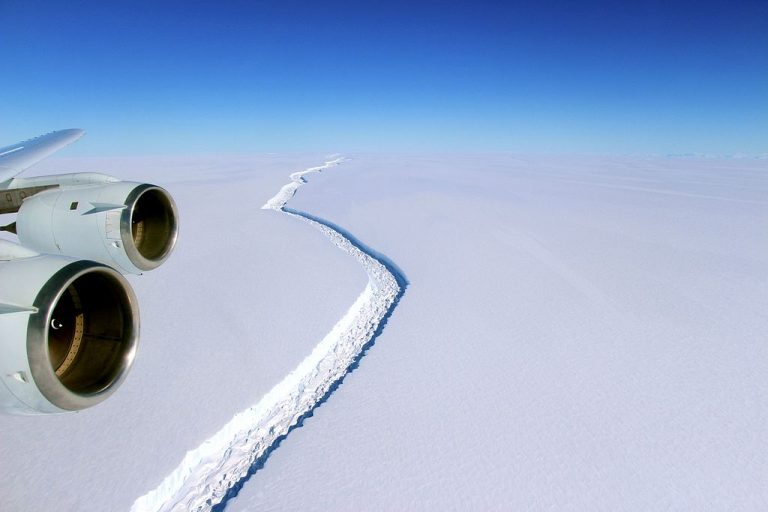Peter Lea Discusses Larsen C Ice Shelf
By Tom Porter
An iceberg the size of Delaware recently broke away from western Antarctica and is now floating in the ocean. While, without doubt, a major event, said Associate Professor of Earth and Oceanographic Science Peter Lea, it was not unexpected. “The crack in the Larsen C ice shelf had been growing for ten years, so it was a question of when, not if, the break-off, or ‘calving’ as it’s known, would happen.”
Ice shelves such as this one, explained Lea, are formed by the continued accumulation of snow, which flows off the mainland and freezes, forming a huge area of ice. “This is essentially how Antarctica gets rid of its excess snow, and we’re left with these huge floating ice shelves, still connected to the land, which can be up to 700 feet thick—that’s more than four times the height of Coles Tower.”
Climate change
On one level, it is part of the natural order of things for ice shelves like Larsen C, and Larsen B (which broke away in 2002), to separate from the mainland, said Lea, so we should be careful about automatically blaming this latest event on climate change.

Climate change
On one level, it is part of the natural order of things for ice shelves like Larsen C, and Larsen B (which broke away in 2002), to separate from the mainland, said Lea, so we should be careful about automatically blaming this latest event on climate change.
Although calving does occur naturally, he explained, it is entirely possible that warming temperatures are helping it along.
“What has been happening around Antarctica is that warmer water, caused in part by climate change and partly by a change in circulation patterns, has been intruding beneath these ice shelves and making them more prone to calving.”
Sea level rise
So how concerned should we be about the breakup of Larsen C and its implications for sea level rise? Not overly, said Lea. “While it’s a sizeable ice shelf, Larsen C was already floating when it broke away, so it won’t add much to the sea level—maybe a fraction of an inch at the most.
Larsen C was attached to the Antarctic peninsula, a finger of land protruding from the northwest of the continent, said Lea, but scientists are much more concerned about what’s happening elsewhere in the region.
“Much of the research being done today is looking at the main part of western Antarctica, where there are glaciers bigger than Larsen C—Thwaites Glacier and Pine Island Glacier for example—and these ice sheets, unlike Larsen C, are grounded on the rock. There are signs that the warming ocean is coming in and causing them to melt.”
These are worrying signs, said Lea, because the western Antarctic has dozens of large ice sheets, some of which look more vulnerable than others to breaking up. “But there’s always the danger of the ‘domino effect,'” warned Lea. Once one glacier floats away, others are more likely to follow as warmer waters flow into the cracks left behind. “It’s like slowly spreading pancake batter,” he says. ” If you scoop away a bunch at the edge, the rest of the batter will flow in faster to fill the gap.”
If (and it’s a big “if”) all the ice sheets in the western part of the continent were to go, said Lea, that would mean a sea level rise of about ten feet. Lea doesn’t want to be alarmist, however. “We don’t know how fast something like that could occur, as we’ve not seen this kind of thing happen before. Scientists have developed models, but we’re still in the early stages of figuring this stuff out. If it were to happen though it would probably take decades or even centuries.
“There is a very real prospect though of the sea level rising by an extra two to five feet this century, which would of course put a lot of stress on coastal locations.”
New academic course
Mounting concern over the issue has prompted Lea to offer a new course in the fall. Addressing Sea Level Rise (EOS 1030) is an interdisciplinary course looking not only at the science of sea level rise, but at wider questions regarding the socio-economic implications and what society can do to respond.
“Sea level rise is, within limits, one of the more certain consequences of climate change, and we’re already seeing its effects. Some Pacific island nations for example are now barely above sea level and we really have to start thinking about how to address these issues.”



